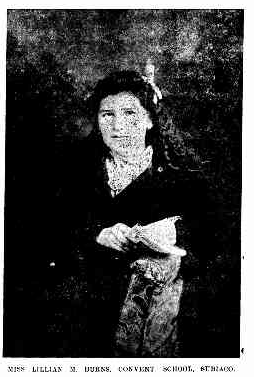One of the interesting things about reading the Postal Directories held at the State Library of Western Australia and researching particular streets in Subiaco was how many single women and single married women who's husbands had died lived there. One of those women was Catherine (Pauline) Riley, the daughter of the Bishop of Perth who took up his position in 1895. He was then promoted to Archbishop just before World War 1.
There are many biographies online about Archbishop Riley and the various roles he played in the life of Perth before his death in 1929. Trove, the database of the National Library of Australia contains articles about the Archbishop, his work, death and funeral in 1929.
Catherine Riley who was also known as Pauline was born on 7 May 1887 and lived with her sisters in Subiaco at Barker Road for many years. She did an oral history interview in 1983 when she was 96 years old about her early life in England and later in Western Australia and Subiaco. Pauline and her three brothers (Charles, Frank and Eric) and sister (Margaret) came out by ship to Fremantle in 1894 after their father was promoted to the Bishop of Perth. Another sister Gwendoline was born in Western Australia.
Pauline returned to England with her younger brother and completed a degree at Cambridge University before coming back to Perth where she gained various relief positions teaching religious instruction and other subjects. During this time she helped out her mother in the family home. She never got married or had children.
Paragraphs from Pauline Riley's oral history 'Pauline Riley Transcription of Oral History October and November 1983' at age 96. Copied below are some paragraphs about the life of women in the early 1900's about her thoughts on marriage, going to Cambridge University and a visit by Mrs Pankhurst.
DM Did you ever think about getting married ?
RILEY No. I never worried about it. I had boyfriends that I met at dances and I had three brothers. And when I went to England at the time I had cousins but I had no boy relations out there. You see I was always meeting younger men in a way because there were a lot of the clergy were youngish men, naturally. But I knew a lot of them not terribly well. It never worried them I wasn't married. That's what all of them here can't understand....As I say men never worried me in that way. I liked men's society. I like talking to them. But it never worried me that I never got married. I don't know why I had sometimes I had small children to look after. I was quite useful when one of my nieces or sister was having a baby. I was called in to come and help....(Moore, 1983, p.38-39)
DM When you were at Cambridge ?
RILEY Cambridge I had a...I was in what they called the...I was in Newman College in what they called the old hall. There were only two women's colleges then, Newman and Gertie. Gertie was out of Cambridge and the girls use to come in by bus in those days. We could ride bicycles...Girls took all sorts of subjects but I was only reading history. Most of the lectures I went to were in the men's colleges or in the colleges which were university ones only. But we went to them and that's how I went to the ones in my brother's college and I think sometimes at King's College - various ones. We went to lectures mainly, or I did, in the morning and you'd get back in time for midday meal. Then after lunch we'd play games hockey or tennis and five's things like that....(Moore, 1983, p.39).
RILEY...Yes well I remember Mrs Pankhurst coming up to talk to us at Newman one night. Of course I'd already imagined her to be a very belligerent sort of woman and that sort of thing but she came very neatly dressed in a plain black frock and talked sensibly. I don't remember what it was all about but I remember being surprised because I always thought that you know women at that time were making a great fuss about getting votes. What did they call it ?
DM Emancipation.
RILEY Emancipation and that sort of thing. But as I say it didn't worry me much because I knew that when I got back here I would have a vote myself and I didn't think anything about it...(Moore, 1983, p.42)
After Pauline's father died in 1929 a collection was taken and they bought a house in Barker Road, Subiaco. She remained there until the deaths of her mother and sisters and then was allocated a flat next to Forest House.
The family donated their collection of toys to the Western Australian Museum. The Riley Riley Collection is subset of the ECU Museum of Early Childhood Collection. There is a photograph of Pauline and three of her brothers and a sister at their house. The collection provides an interesting look of children's toys and play at the turn of the 20 th Century.
References
Moore, Donna,1983, 'Pauline Riley. Transcription of Oral History October and November 1983'. The State Library of Western Australia.
http://museum.wa.gov.au/research/collections/social-history/history-department-collection/riley-family-collection-subset-ec-0

"....This photograph shows the Riley family children, sons and daughters of Perth’s first Anglican Archbishop, C O Riley in the grounds of Bishop’s House Perth, 1896. L-R Margaret, Charles, Frank (‘Basil’), Catherine (‘Pauline’) and Eric. A sixth child, Gwendoline was born a year after this photo was taken..." (Western Australia Museum)







